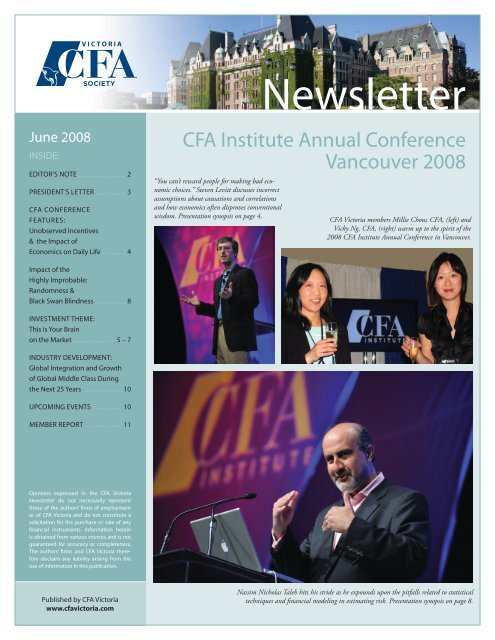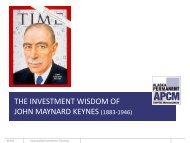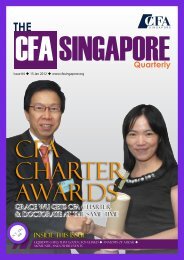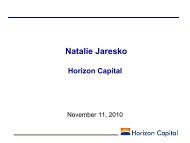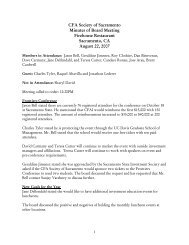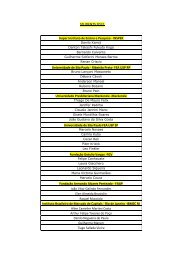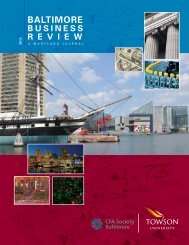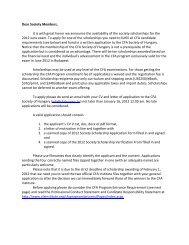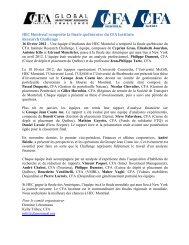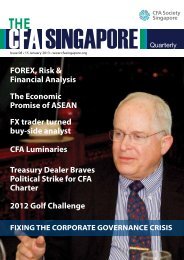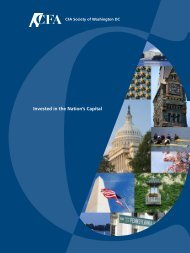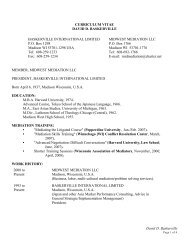newsletter - local CFA Societies
newsletter - local CFA Societies
newsletter - local CFA Societies
Create successful ePaper yourself
Turn your PDF publications into a flip-book with our unique Google optimized e-Paper software.
NewsletterJune 2008Inside:Editor’s Note................ 2President’s Letter.. . . . . . . . . 3<strong>CFA</strong> ConferenceFeatures:Unobserved Incentives& the Impact ofEconomics on Daily Life.. . . . . . . 4<strong>CFA</strong> Institute Annual ConferenceVancouver 2008“You can’t reward people for making bad economicchoices.” Steven Levitt discusses incorrectassumptions about causations and correlationsand how economics often disproves conventionalwisdom. Presentation synopsis on page 4.<strong>CFA</strong> Victoria members Millie Chow, <strong>CFA</strong>, (left) andVicky Ng, <strong>CFA</strong>, (right) warm up to the spirit of the2008 <strong>CFA</strong> Institute Annual Conference in Vancouver.Impact of theHighly Improbable:Randomness &Black Swan Blindness .......... 8Investment Theme:This is Your Brainon the Market. ............. 5 – 7Industry Development:Global Integration and Growthof Global Middle Class Duringthe Next 25 Years .. . . . . . . . . . . . 10Upcoming Events .. . . . . . . . . 10Member Report............. 11Opinions expressed in the <strong>CFA</strong> VictoriaNewsletter do not necessarily representthose of the authors’ firms of employmentor of <strong>CFA</strong> Victoria and do not constitute asolicitation for the purchase or sale of anyfinancial instruments. Information hereinis obtained from various sources and is notguaranteed for accuracy or completeness.The authors’ firms and <strong>CFA</strong> Victoria thereforedisclaim any liability arising from theuse of information in this publication.Published by <strong>CFA</strong> Victoriawww.cfavictoria.comNassim Nicholas Taleb hits his stride as he expounds upon the pitfalls related to statisticaltechniques and financial modeling in estimating risk. Presentation synopsis on page 8.
2NewsletterJune 2008Editor’s NoteGord Walker, <strong>CFA</strong>Welcome to the inaugural issue of the <strong>CFA</strong> Victoria Newsletter. This issue is a milestone for <strong>CFA</strong> Victoria.The society has grown to where it can now regularly provide such a report to members and others, allowingthem to become more aware of <strong>CFA</strong> Victoria’s goals and activities. I hope you enjoy reading thisfirst effort and all of our subsequent issues.The launch of this <strong>newsletter</strong> fortuitously coincided with <strong>CFA</strong> Vancouver hosting the 2008 <strong>CFA</strong> InstituteAnnual Conference, whose theme was Connecting Theory and Practice: Investment Management in theGlobal Economy. Given the added interest of this year’s Conference being held just a short float-planeride away, this issue of the <strong>CFA</strong> Victoria Newsletter prominently features material from the Conference.We have two <strong>CFA</strong> Conference features, provided by Philippe Monier, <strong>CFA</strong>, and Vicky Ng, <strong>CFA</strong>, who attended.The first is Philippe’s synopsis of the presentation by the Conference’s opening speaker – StevenLevitt of Freakonomics fame. The second is Vicky’s synopsis of Nassim Nicholas Taleb’s presentation onThe Impact of the Highly Improbable: Randomness and Black Swan Blindness. Both speakers were apleasure to listen to, enlightening and entertaining, and Philippe and Vicky have each done a fine job ofcapturing the spirit and content of these sessions for you to enjoy.A common thread that ran through Levitt’s and Taleb’s presentations is that neither of them seemed tohave much faith in homo economicus – that rational, perfectly informed, and self-interested individualwho is the theoretical cornerstone of conventional economic and investment theory. Following thisthread a little further, this issue’s Investment Theme examines how flesh-and-blood investors reallymake decisions and explains some of the biological underpinnings of innate cognitive functions thatshape our decision-making processes. We thank the Toronto <strong>CFA</strong> Society for allowing us to reprint thisarticle by Anne Maggisano, This is Your Brain on the Market, from its <strong>newsletter</strong>, The Analyst.Much of the groundwork necessary to launch the <strong>CFA</strong> Victoria Newsletter was done by <strong>CFA</strong> Victoriaboard members Chelsea Kittleson and Landon Downs. They each exemplify how volunteers can bestgive back to the profession and the community, and I thank them for their efforts.Wrapping up, I’d like to say how much I personally enjoyed attending the <strong>CFA</strong> Institute Annual Conferencein Vancouver and how impressed I was with the character of the individuals I spoke to there, evidentin their knowledge, intelligence, and commitment to enhancing our profession. The <strong>CFA</strong> charteris not a credential easily earned, but charterholders can deservedly take pride in belonging to a selectgroup whose membership is based on merit and integrity. In a small way, the <strong>CFA</strong> Victoria Newsletter isintended to help <strong>CFA</strong> Victoria members benefit more fully from the privilege of belonging to this communityand enable others to better understand what the <strong>CFA</strong> designation represents.Share your knowledge and insights with readers of the <strong>CFA</strong> Victoria NewsletterDo you have a story idea or a topic that willinterest and inform <strong>CFA</strong> Victoria members?Send an e-mail to let us know what you wouldlike to see in the <strong>newsletter</strong> or if you want towrite something yourself.Potential topic areas include, but are notlimited to:• Industry developments• Investment themes• Profiles of notable membersIf you have an idea for an article,please send it toGord Walker, <strong>CFA</strong>Gordon.Walker@RBC.com
President’s LetterAnna Nemeth, CIM, <strong>CFA</strong>In 1997 <strong>CFA</strong> Victoria was founded, with just 14 members, as a Chapter of the Vancouver Society ofFinancial Analysts. Today we have our own society, which has grown to 80 members. To guide the futuredevelopment of <strong>CFA</strong> Victoria, our board of directors recently developed the society’s first strategic planto lead <strong>CFA</strong> Victoria to 2012 and beyond. Our mission is to1. Promote professional excellence and the highest ethical standards2. Support society members and <strong>CFA</strong> candidates through informative, relevant education,and networking opportunities3. Build awareness of the <strong>CFA</strong> Charter within the <strong>local</strong> communityIn keeping with this mission, <strong>CFA</strong> Victoria has held many events over the past year where attendeeshad the opportunity to hear interesting and highly qualified speakers discourse upon various financialissues. Andrew Shortreid, Vice President and Program Chair, has done a wonderful job organizing theseevents, which altogether represent six hours of Professional Development (PD) credits. Notable amongthe speakers was Noreen Harrington, the whistle-blower who tipped off New York Attorney GeneralEliot Spitzer to illicit trading in mutual funds in 2003; Noreen captivated attendees at both our <strong>CFA</strong>Victoria Candidate Reception and our Christmas Dinner/Charter Award Ceremony.We have also sought to raise the profile of the <strong>CFA</strong> designation and of <strong>CFA</strong> Victoria. Jeff Good, PublicAwareness Chair, and Chelsea Kittleson, Education Chair, have both been instrumental in this. Ahighlight of our public awareness campaign is the society’s sponsorship of the arts in Victoria throughthe Victoria Symphony, Pacific Opera of Victoria, the Victoria Operatic Society, and the Belfry and theLangham Court Theatres. <strong>CFA</strong> Victoria is also lead sponsor for two upcoming shows at the Art Gallery ofGreater Victoria.On the educational side, Chelsea has organized information sessions at UVIC for <strong>CFA</strong> candidates as wellas the Boston Mock Exam for candidates wishing to confirm their ‘battle-readiness’ a month beforethe actual <strong>CFA</strong> exams. Furthermore, she has administered our scholarship program through which weaward up to 10 scholarships to worthy candidates each year.Financially, <strong>CFA</strong> Victoria is on solid footing. We thank our Treasurer, Trent Moore, for keeping us wellwithin budget and in a surplus position. Revenues from job postings and from annual dues are the twobiggest contributors to our earnings.Jeffrey Hamel, our Membership and Technology chair, has been key in getting our new and improved<strong>CFA</strong> Victoria website launched (www.cfavictoria.com). Moreover, during his tenure the society membershiphas grown by 14% and we are now striving for 100 members within the next three years.<strong>CFA</strong> Victoria’s success has come through the hard work and countless volunteer hours of our currentand past boards. I am fortunate to have had the privilege of working with such enthusiastic, creativeand dedicated individuals during my six years of involvement with the society. Leaving our board thisyear are Chelsea Kittleson and Landon Downs, both of whom have contributed much to the society.I thank them on behalf of our board and our members. In addition, I offer special thanks to Sue-AnneFimrite, Past President, who has been involved with the board since inception and has contributedhundreds of volunteer hours over the past 11 years. We will miss her energy and effervescence.In closing, I urge all members to consider volunteering to help <strong>CFA</strong> Victoria better serve our membersand fulfill our mission. Participating on a society committee is a good way to expand your network withinthe financial community and enhance your career opportunities. We are always looking for memberswilling to contribute some of their time, energy and ideas. Please contact me at anna.nemeth@td.com ifyou would like more information on how you can help.NewsletterJune 20083
4NewsletterJune 2008<strong>CFA</strong> Conference FeaturesUnobserved Incentives and the Impactof Economics on Daily LifePhilippe Monier, <strong>CFA</strong>Steven D. Levitt, coauthor of the bestsellerFreakonomics, and dubbed “the IndianaJones of Economics” by the Wall StreetJournal, was opening speaker at the <strong>CFA</strong>Institute Annual Conference in Vancouver onMay 11, 2008. Director of the Becker Centeron Chicago Price Theory at the University ofChicago, Levitt is noted for his pioneeringwork on natural experiments in economics.A witty and entertaining presenter whoanalyses economic activities with a somewhatdisconcerting approach, there is little doubtthat he entertains his students while educatingthem in his brand of economics.Levitt began by illustrating the value ofincentives, telling the story of an InternalRevenue Services employee, JohnSzilagyi, who was struck by the oddnames of children listed as dependentson tax returns – names such as “Fido”.Szilagyi suggested in the early 1980s that aSocial Security number be required for eachchild claimed on the tax form, but it took fiveyears and considerable persistence on hispart before the change was implemented.After the change, a sudden ‘disappearance’of some seven million children in the U.S.occurred, obviously children invented forthe purpose of cheating on income tax. Thissimple innovation championed by Szilagyisaved the government roughly $2 billiona year from fraudulent claims, but the onlyreward he eventually received was a $25,000bonus.One lesson from this story is that incentivesstrongly influence not only the decision tocheat, but also the generation of ideas. Thousandsof IRS employees over several decadescould have had the same insight as Szilagyi,but in a situation where initiative and changewere not valued they had little incentive toact on such an idea. Another lesson is thatwhile ideas seem scarce, even breakthroughideas are easy to find if you really look. Levittstated, though, that one often needs to “fightthrough conventional wisdom”.Levitt explained that he is not the kind ofeconomist who makes big statements onhow the world works, and claimed that manyeconomists today are actually less interestedin the economy than in math. A Harvardgraduate and a Ph.D. in economics from MIT,he surprisingly admitted to being poor inIf you give people bad incentives,then things go wrong.mathematics himself, relying in his work onnot much more than a good knowledge ofeconomics.Explaining why his career took the path it has,Levitt said his father advised young Stevento follow his example and concentrate onwhat Steven was good at. Levitt senior was amedical doctor who specialized in medicineregarding intestinal gas, an area where heexpected little competition. Ultimately, hebecame a top-ranked specialist in that area.Taking his father’s advice to heart, StevenLevitt concentrated on the empirical study ofthe stuff and riddles of everyday life, and hisconclusions regarding these matters regularlyturn conventional wisdom on its head. In thisarea, now sometimes referred to as Freakonomics,Levitt expected little competitionamong economists!To give an example of the sort of questionsthat interest him, Levitt told the story of aman who started a business selling doughnutsin company offices. Trusting peopleto be honest, in each office he left a box ofdoughnuts with a price list and a locked boxin which people paid. Most people liked theservice and paid honestly, so the business wasa success with net annual revenues of some$100,000 in the 1980s. The entrepreneur thenoffered Levitt a mass of data on his business,which he had conscientiously recorded eachday for 15 years, asking if Levitt could findways to improve the business. Levitt thenbuilt a model to optimize profitability,but his complex algorithm showed thathe could improve net revenues by, atbest, $200 a year!During the process, though, Levitt discoveredthat this business operator hadraised prices only four times in those 15 years.Levitt thought that although the businessmodel was good, the operator was probablyunder-pricing. While the operator had dailyfeedback on the quantities of doughnuts heshould supply at each location, he had littlefeedback on how customer demand reactedto price changes. Without empirical data, hisability to confidently make pricing decisionswas limited.Levitt said that since the publication ofFreakonomics, other business leaders hadasked him for advice. He generally was happyto provide his services … for free … theonly condition being that these businessesallow him to use the data he collected for hispublished research. However, the impact ofhis efforts has not always been as productiveas it could be.Continued on page 9.
Investment ThemeThis is Your Brain on the MarketBy Anne Maggisano, CIMReprinted from The Analyst, March 2008, courtesy of the Toronto <strong>CFA</strong> Society.NewsletterJune 20085“Man will become better when you show him what he is like.”– Anton Chekhov, as quoted by Steven Pinker in The New York Times Magazine (January 13, 2008)The impact and scope of evolutionarypsychology is hard to ignore these days.In the popular press, The New York TimesMagazine recently featured an article bySteven Pinker as its cover story, arguing thathuman morality must be understood to havea biological cause. If this isn’t indicative of amove to the mainstream, then one only hasto look to the institutional bastions of financeto understand how what was at one time acontroversial topic has now becomethe norm. Harvard University offers anannual education course for executives,“Investment Decisions and BehaviouralFinance,” designed to illuminatehow our human decision-makingprocess can be applied to the investmentcontext. The most prestigious offinance institutions, <strong>CFA</strong> Institute, chooses tooffer their “Efficient Markets and BehaviouralFinance” webcast program for free on theirweb page. Our very own Toronto <strong>CFA</strong> Societyre-invited Terry Burnham, author of MeanMarkets and Lizard Brains: How to Profit fromthe New Science of Irrationality, to speak for asecond time at a luncheon seminar in Januaryof this year.This article reviews developments in therealm of cognitive psychology and theirimplications for our understanding of marketefficiency. Specifically, it demonstrates howour individual and collective decision-makingprocesses provide a mechanism to explainhow and why markets become inefficientfor periods of time. Through understandingthe mechanism of irrationality, investors canprofit in two ways. First, by learning how tosystematically manage their own individualdecision-making biases. Second, by identifyingopportunities that arise when capital marketsbecome inefficient due to widespreadbiased decision-making.Involuntary decision-makingFunctional MRI neuroimaging studies showthat much of our decision-making is low-levelprocessing, occurring in the oldest parts ofthe brain from an evolutionary standpoint:Many things other than money that arefound rewarding also work through thispositive feedback system: beautiful faces,exercise, food, the anticipation of narcotics.the limbic system, basal ganglia and brainstem.These low-level processes are designedto pick up regularities in the environmentunconsciously and automatically, without ourcontrol or awareness of them. For example,Daniel Levitin in his book This Is Your Brain onMusic summarizes how this part of the braindetects and processes the meter, pitch, andloudness of a song instinctively, motivatingour assumptions about the song even beforehigher-level cortical areas that are involved inknowledge, cognition, and memory becomeinvolved. For investors looking at stock marketprice fluctuations, the hard-wiring in ourbrain unconsciously recognizes patterns suchas rising prices, motivating our convictionthat future prices will follow that trend. Thebrain continuously updates its expectationsabout the future, taking immense satisfaction(an emotional response) when the real worldmatches our predicted expectations.In fact, scientists have discovered that our anticipationor expectation of a reward (i.e. thatstock prices will go up) activates the nucleusaccumbens, the part of the ancient brain thatmediates pleasure and positive well-beingthrough the neurotransmitter dopamine. Thissets up a positive feedback “reward system”whereby past performance sets up expectationsthat the trend will continue, activatingthe release of dopamine into the nucleusaccumbens and creating emotions of excitement,pleasure, and greed. For example,when we buy a lottery ticket or a stock thatwe believe is a clear winner, the possibility offinancial gain activates the reward systemeven without the outcome of winningthe money. Moreover, if in fact wedo make money, we will become moreexcited about the possibility of makingmoney again and we will be more likelyto re-create the conditions that entailthe possibility of making money again.Many things other than money that are foundrewarding also work through this positivefeedback system: beautiful faces, exercise,food, the anticipation of narcotics. Becausethe greed and emotion from this reward systemlies below our level of awareness, it drivesour behaviour without any involvement ofthe higher cortical areas of the brain that areintimately involved in conscious cognition.There is a second system that is implicatedin our unconscious decision-making: theloss-avoidance system. Once we understandthat our ancestral brain is designed to detectregularities in our environment, we canconceive how it is equally responsive to anychange in that environment because changecould signal imminent danger. For example,Continued on next page.
6NewsletterJune 2008Investment Theme“This is Your Brain on the Market” continued from page 5.when we predict that a stock price will continueto follow its upward trend, but it in factreverses direction, our brain senses the breakin trend and activates that part of the brainthat generates our emotional responses offear and anxiety (the amygdala). Once again,it is the anticipation that something bad willhappen—the pain of loss—that guides ourintuitive response to flee, whether that berunning away from a lion, or selling a stockimmediately. Implicated in the loss-aversionsystem is the release of noradrenaline fromthe locus coeruleus, a hormone that leadsto the panic reaction that can shut downother systems, including the frontal cortex.Once again we can see that contrary to whatwe would expect, it is our primal base-levelresponses that are driving our behaviour, andthey operate somewhat independently ofour higher cognitive levels of thinking andrational decision-making.Collective decision-makingThese studies have been extended tounderstand how individuals make decisionsin the context of a large group. The mostwell-known study of social conformity andsocial independence was performed in the1950s by Solomon Ash. Individuals are askedwhich line (A, B, or C) is equal in length to lineX. Most people choose the correct answer Awhen they are asked on their own. However,when positioned in a group setting where asignificant proportion of the members areprimed to give an incorrect answer, that sameindividual will change his/her answer to conformto the group norm.Continued on next page.<strong>CFA</strong> VICTORIA12th Annual Golf TournamentFriday July 11, 2008Olympic View Golf Course(www.golfbc.com/courses/olympic_view)Golf (including cart) and dinner$125 (<strong>CFA</strong> Victoria Members) and $150(non-Members), Dinner only: $40If your company would like to sponsor a hole,the cost is $100(Prizes are encouraged as well)Please contact Charles (see below) for more informationFirst tee-off time is 12:00,last tee-off time will be approximately 14:00Texas Scramble formatPrizes for Best score, Worst score,Closest to the pin, Longest drive, etc.BBQ dinner starts at approximately 6:00pmTo reserve, please send the following informationas soon as possible to:GOLF TOURNAMENTAttn: Charles VolkovskisEmail: charles.volkovskis@bcimc.com,Fax: (250) 387-7874Name, CompanySociety Member: Yes/NoClub Rentals: Yes/NoSkill Level: Good/Average/BadSpecial Requests: foursome, tee-time, etc.Make cheques payable to:<strong>CFA</strong> VICTORIAForward to:Charles VolkovskisbcIMC, 3rd Floor, 2940 Jutland Road,Victoria, BC, V8T 5K6
Investment Theme“This is Your Brain on the Market” continued from page 6.NewsletterJune 20087Gregory Burns extended this study to determineif social conformity, or agreeing with thegroup even when the group is incorrect, is aresult of conscious decision-making. Usingfunctional MRI technology to map the brain,he discovered that social conformity doesnot result in activation of the cortex andhence is not a result of conscious decisionmaking.More significantly, social conformityactivates the regions of the brain involved ininstantaneous perception, suggesting thatour perception can be altered by social influences.In contrast, social independence fromthe group, or standing up for one’s beliefs inthe face of group opposition, activates theamygdala—that region of the brain that isinvolved in the emotion of fear and theactivation of the loss-aversion system.These studies suggest that socialconformity is once again an instinctiveprocess, mediated either by an unconsciouschange in our perception or anaversion to the fear response and thepotential for pain.How does our decision-making affectmarket efficiency?Under conditions of market efficiency, themarket price of an investment reflects anunbiased estimate of its value. For practicalpurposes, what this means is that investorsare unable to consistently and systematicallybeat the market and the best course ofaction is to choose indexation over activemanagement. However, there are momentswhen markets display inefficiencies—mostnoticeably during speculative bubbles andcrashes—and investors can choose to exploitthese moments for profit.One explanation for how market efficiencycomes about is put forward by William Sharpeand Michael Mauboussin among others as the“Wisdom of Crowds” approach. The Wisdomof Crowds theory of market efficiency arguesthat there are three necessary and sufficientconditions under which markets are efficient:diversity, aggregation, and incentives. Amarket is efficient if it is cognitively diverse,if there is a method by which to bring theinformation together, and if there are incentivesfor being right. However, if one of thesethree conditions breaks down, then marketsbecome inefficient.Accepting the assumptions of the Wisdomof Crowds theory, the results of behaviouralfinance threaten market efficiency at the levelof diversity. More specifically, as Mauboussinpoints out, it is not the irrational behaviour ofindividuals that threatens market efficiency,Investors must put policies and proceduresin place by which to counteractour human, instinctive drive to act basedon sub-optimal decision making.but rather the behavioural tendencies for socialconformity that are implicated in marketinefficiencies. This view is also expressed byWilliam Sharpe, Nobel prize winning economist:“The basic argument [of the Wisdomof Crowds] is that if we have enough peopleeven though they may be ill-informed andirrational coming to market, it is entirely possiblethe prices of assets, thereby true risksand rewards, are what you would get if theywere all rational and well informed.”What this means is that investors must lookfor signs of behavioural social conformity inthe marketplace as an indicator for marketinefficiency. Such signs can appear in thepopular press and/or in the markets themselvesand take the form of extreme bullishnessor bearishness, or sentiments of fear andgreed. In learning to locate social conformity,one can take advantage of investments thatare priced below their intrinsic value.How can individuals becomebetter investors?The evidence of behavioural studies ofdecision-making suggests that humansgenerally behave in a sub-optimal mannerwhen it comes to investing. The studies showthat, broadly speaking, decisions are madeunconsciously in reaction to our hard-wiredtendencies to look for regularities in ourenvironment and create expectations basedon those patterns or on violations of thosepatterns. Moreover, our perception of ourenvironment is unconsciously influenced bythe group context in which we are placedeither out of fear of independence, orby a change in perception.Studies of our behavioural tendenciesargue implicitly that investors mustput policies and procedures in placeby which to counteract our human,instinctive drive to act based on suboptimaldecision-making. For example, onemust objectively calculate the full spectrumof outcomes for an investment in order tocounteract our instinctive belief that pasttrends will continue into the future. Also, it isimperative to create a list of stocks to buy atlow prices in order to counteract our instinctivedrive to sell at market bottoms. Third, onemust insulate oneself from daily fluctuationsin market price in order to prevent oneselffrom making investment decisions based onprice instead of value. Finally, one can favourlong-term decision-making to counteractshort-term emotional responses. The numberof behavioural modifications to counteractour instinctive tendencies is endless; however,by putting into place systematic proceduresto override these tendencies, we may becomebetter investors.
8NewsletterJune 2008<strong>CFA</strong> Conference FeaturesThe Impact of the Highly Improbable:Randomness and Black Swan BlindnessVicky Ng, <strong>CFA</strong>Over the past 12 months a number ofevents have rocked the financial markets,and how many of us can honestly say thatwe clearly anticipated such incidents or theirseverity? Speaking at the <strong>CFA</strong> Institute AnnualConference in Vancouver on May 12, NassimNicholas Taleb explained why extreme eventsare hard to predict and why these eventsoften have catastrophic impacts. Currently avisiting professor at London Business Schooland formerly dean’s professor in the sciencesof uncertainty at the University of Massachusetts,Professor Taleb is the author of Fooledby Randomness and more recently The BlackSwan: The Impact of the Highly Improbable,two highly regarded books that discuss, oftenthrough anecdote, Taleb’s thoughts on howuncertainty works.such theory is valid only in situations of “mildrandomness”, a world he calls Mediocristan.For example, adding one additional datapoint to a reasonably large sample set of humanheights will probably not greatly changethe distributive properties of the set becauseextreme human heights are not that far fromthe mean. In contrast, adding the annualincome of the world’s richest person to arandom sample set of the incomes of 10,000people would change the sample distributionconsiderably. In other words, in some casesa small number of occurrences can accountfor a large proportion of the total outcome.Another example is that there are about267,000 drugs available on the market, butonly 5% of all drugs account for most of theprofits of pharmaceutical companies. TalebNassim Nicholas TalebIn his presentation, Taleb explained that thecentral problem concerning extreme eventsis that the smaller an event’s probability, thelarger our sample set must be to reliablyestimate that probability, and as the probabilitybecomes smaller the more consequentialthe impact of any error in estimating it willbe on the magnitude of the actual outcome.Investors and others in the prediction businesshave to be conscious not only of theuncertain probability of extreme events, butalso the uncertain magnitude, good or bad,of these events. How, he asked, do analystsjustify labelling something a 1-in-10,000-yearevent when their sample sets cannot covernearly so long a time period? His answer:purely from theory.Mediocristan vs. ExtremistanModern portfolio management often usesstatistical theory based on the Gaussiandistribution (the normal distribution) toforecast event probabilities. Taleb believes“I shiver at the thought that something fails.”provided further examples, pointing out thatTo illustrate the difficulty in more worldlytail distributions dominate the likelihood ofterms, Taleb compared the characteristicssocial and economic events. These situationsof government change in Italy and in Saudibelong to another world, one that TalebArabia: the Italian government changes frequentlyand somewhat unpredictably (highcalls Extremistan. He warns that there is noreliable structure in the probability distributionsof Extremistan.volatility), but each change has relatively littleimpact; the Saudi government changes verylittle (low volatility), but a change in governmentcould have a severe impact in manyTaleb believes that statistics and probabilityestimates are irrelevant in forecastingways (consider the 1979 revolution in Iran).extreme events and our world is shaped byPrognosticators also suffer from the fallacy ofthe dynamics of Extremistan. Although mostsingle event probability. Events in Extremistanpeople rely on past experience (i.e. data fromdo not follow a typical pattern. One mightprevious periods) to forecast the future, pastsuccessfully predict the occurrence of anextreme probability distributions – generallyreferred to as tail distributions – areevent yet be totally wrong about the formthat the event actually takes. An examplenot indicative of future extreme probabilityof this was the confidence of many knowldistributions:previous outliers do not predictfuture outliers.Continued on next page.
NewsletterJune 20089“Unobserved Incentives and the Impact of Economics on Daily Life” continued from page 4.In one case, a consumer electronics companyapproached him for marketing advice. For along time, this company had used both TVadvertising three times a year and full-pageads in Sunday newspapers every week ineach major newspaper market. Consultantsbrought into investigate the effectiveness ofthis advertising had reported a high correlationbetween sales and the TV advertising,but found that the newspaper advertisingwas much less effective. Levitt was suspiciousof these findings and found that the TVadvertising had coincided with dates suchas Christmas and Fathers’ Day when sales arehigher than normal regardless of advertising.In other words, the consultants had confusedcorrelation with causality.Levitt suggested testing the newspaperadvertising effectiveness through an experimentwhere the company would stop advertisingin selected markets and compare salesin those markets with sales in markets wherethe ads continued. The company refused todo this, since the <strong>local</strong> salespeople in the firstset of markets would be up in arms if newspaperadvertising was interrupted. Interestingly,Levitt found that such an ‘experiment’had been done inadvertently: an intern’smistake had led to no newspaper ads in thePittsburgh market for three months – withoutany noticeable impact on sales. Despite thisevidence, which Levitt felt warranted a morethorough test, the company continues toadvertise in the Sunday papers every weekwithout knowing if this is a total waste ofmoney. Such is the battle against conventionalwisdom!During the Q & A session, Levitt was askedwhat incentives the government shouldprovide to prevent the sort of problems thathave damaged the CDO and credit marketssince last summer.After commenting on various aspects of thisissue, stating that “if you give people badincentives, then things go wrong”, he opinedthat a government bailout is the worst thingto do since “you can’t reward people for makingbad economic choices”, drawing applausefrom the audience.“The Impact of the Highly Improbable: Randomness and Black Swan Blindness” continued from page 8.edgeable people in 1914 that a few weeks oflimited battle would be enough to decide theoutcome of what tragically became the FirstWorld War.Taleb stated that we therefore need toconsider two layers of stochasticity – one regardingevent occurrence and one regardingan event’s impact. Even if we could reliablypredict the probability distribution of an extremeevent, it will remain difficult to predictthe event’s consequences.Moving on to discuss financial institutions, Talebsaid that the global banking system usedto look like the governance situation in Italy,but now looks more like that in Saudi Arabia– “I shiver at the thought that something fails”.As the banking network (and other networkssuch as power transmission grids) comes toconsist of fewer but larger entities, there willprobably be fewer and fewer small shocks(e.g., bank runs), but network effects due toconcentration and nonlinearities could makelarge, infrequent shocks more consequentialthan in the past.Hedge fund returns are a case of life inExtremistan. A problem in the hedge industrycited by Taleb is that a steady stream ofpositive returns (suggestive of an option-writingstrategy) can be suddenly followed by asuddenly ruinous negative return. One causeof this problem is the difference betweenthe time scale used for manager compensationand that needed to realistically analyzeperformance data – a hedge fund managerwill be well compensated during the steadyperformance periods, but when disasterstrikes investors could lose all their profitseven though the manager keeps any bonusesbased on previous gains. Taleb believes thatmany investors expose themselves to such ahazard because they do not understand thenature of risk. For example, some people failto recognize that exposure to a 1-in-30-yearevent is still risky even if their exposure lastsfor only 15 years.During Q & A, Taleb prescribed the use ofqualitative methods in Extremistan to avoidthe pitfalls of black swans and wonders whyanybody would rely on a single number tomeasure risk, especially one already provento be a poor measure. He also reminded theaudience that black swans can have a positiveimpact, but cautioned that good black swansusually happen over time while bad blackswans tend to go “Boom!”.
10NewsletterJune 2008Industry DevelopmentGlobal Integration And Growth Of Global MiddleClass During The Next 25 YearsThe 21st century will be “the most religious in human history.”At the <strong>CFA</strong> Institute 61st Annual Conference,Thomas P.M. Barnett, author of the forthcomingbook Great Powers: America and theWorld After Bush (January 2009), discussedthe dominant trends that will shape the worldduring the next 25 years.In his presentation, Barnett divided the worldinto two groups: those regions that have fullyintegrated and those regions that have not.The former group, which has largely recognizedthe benefits of economic integrationand globalization, includes North America,Europe, Russia, Australia, and parts of SouthAmerica. The latter group − Africa, the MiddleEast, and southeastern Asia − has resistedthe benefits of economic integration andglobalization.According to Barnett, globalization can acton a regional basis to reduce the number ofcountries that have not integrated. For example,China could help Vietnam emerge fromthe gap, whereas Brazil may eventually havea similar impact on countries like Venezuela.Barnett suggests the United States couldserve as a model in this process because itsstates unified out of mutual self-interest topromote commerce and common security.Barnett believes that this integration, with itsown regional variations, will be the dominantdynamic of the next 25 years.Additionally, the shift will serve as a catalystfor interesting, unexpected results. For example,Barnett believes that the 21st centurycould be the most religious in human history.He argues that as residents of newly integratingcountries begin to lose a <strong>local</strong> culture − aculture that may have been substantiallyunchanged for hundreds of years − theywill need to find a new basis for a code ofbehaviour. According to Barnett, this searchfor spiritual guidance will result in greaterreligious pluralism in which far more choiceswill be available than in the past.Continued on page 12.Upcoming <strong>CFA</strong> Victoria Programs, Events and NewsWARHOL: Larger Than LifeArt Gallery of Greater Victoria<strong>CFA</strong> Victoria – lead sponsorExhibitionMay 30 to August 24,Gallery HoursReception and MixerFriday, July 11, 8:00pmOne of the major artistic innovators of the 20thcentury, Warhol’s fame spread well beyond paintingand printmaking. Filmmaker, sculptor, author,collector, publisher, provocateur, music producer,celebrity—Warhol understood and negotiatedthe ride of fame, a sophisticated arbiter and manipulatorof popular culture and fashion.Warhol: Larger than Life is an expansive project ofover 150 paintings, drawings, prints, sculptures,photographs, archival ephemera and films spanningsome four decades of production. Workingdirectly with The Andy Warhol Museum inPittsburgh, PA, the Winnipeg Art Gallery enjoyedfull access to its considerable collection of art andarchives in organizing this exhibition.<strong>CFA</strong> Victoria Annual General MeetingMonday June 9, 4:30pmBC Investment ManagementCorporation Boardroom3rd Floor, 2940 Jutland Road, Victoria, BCRSVP: Anna Nemeth @ 356-4098or anna.nemeth@td.com<strong>CFA</strong> Victoria hosts Lunch withWestport Innovations Corporate PresentationLate June, check <strong>CFA</strong> Victoria website for detailsSince 1995, Westport Innovations has engagedin the research, development, and marketingof high-performance engines and fuel systemswhich use gaseous fuels such as compressednatural gas (CNG), liquefied natural gas (LNG),hydrogen, and hydrogen-enriched compressednatural gas (HCNG).For more information on Westport Innovations,go to www.westport.com<strong>CFA</strong> Victoria 12th Annual Golf TournamentFriday July 18Olympic View Golf CourseSee page 6 for further tournament details.Moss St. Paint-In<strong>CFA</strong> Victoria – lead sponsorJuly 19The Art Gallery of Greater Victoria’s Annual MossStreet Paint-In (a not-for-profit event) featuresinvited professional and emerging artists fromVictoria and Region who demonstrate their artto 30,000 visitors walking Moss Street from FortStreet to Dallas Road. The Paint-In offers visitorsan opportunity to meet and discuss the artists’work and methods and to see an enormous varietyof professional work at one time.<strong>CFA</strong> Victoria and Polaris Minerals hosta Site Visit to the Orca QuarryCompany sponsored visit to industrial site for<strong>CFA</strong> Victoria Members and FriendsPort McNeil, BCMid-August, check <strong>CFA</strong> Victoria website for detailsFor more information on Polaris Minerals or theOrca Quarry, go to www.polarmin.com
NewsletterJune 200811Member ReportWelcome New Members<strong>CFA</strong> Victoria is pleased to welcome the followingnew members to our society:<strong>CFA</strong> Victoria Membership Profile<strong>CFA</strong> Victoria now has 80 members and continues to grow. The following is a breakdown of ourmembership by industry and title.Johann L. Kuntze, <strong>CFA</strong>Ministry of Finance,Treasury BoardJill Michaela Sing, <strong>CFA</strong>Hayes Stewart Little & Co.<strong>CFA</strong> Charterholder Information<strong>CFA</strong> charterholder 87%Non-charterholder 13%Industry ClassificationsBroker dealer, Investment Banking 11%Members on the MoveLandon N. Downsto Macquarie Capital Markets Canada Ltd.landon.downs@gmail.comWould you like to be includedin Members on the Move?It’s important to keep your contact informationup to date and let others knowwhere they can reach you.Please let us know if you’re changingjobs or making any other move. Sendyour information to Gordon.Walker@RBC.com with “Members on the Move” in thesubject line.Commercial/Retail Banking, Bank Trust Departments 8%Corporate, Public Sponsor & Foundation/Endowment 2%Insurance Company 2%Investment Company/Mutual Fund 23%Investment Management Consulting 20%Other businesses incl. government, academic, misc. 35%Titles & OccupationsAnalyst, Equity & Fixed Income 3%Analyst, Other 5%CEO, Chairman, Partner, Principal 5%Chief Investment Officer 4%Investment Banker 2%Investment Counsellor 14%Investment Firm Manager 3%Portfolio Manager 21%Sales/Marketing 7%Securities Trader 4%Other 33%
NewsletterJune 200812<strong>CFA</strong> Victoria Mission“Global Integration...” continued from page 10.Barnett’s presentation concluded with observationsabout China and its future. He notedthat the Chinese phenomenon is only 25years old. In that quarter century, China hasgained economic experience that took theUnited States 125 years to accumulate.For a country that would otherwise be characterizedas an emerging economy, China hasrather unusual demographics, Barnett said.The country’s one-child policy has resultedin a population in which males significantlyoutnumber females.The Last Word<strong>CFA</strong> Victoria promotes the highest standardsof integrity, professionalism andethical behaviour within the investmentindustry, and encourages professionaldevelopment through the <strong>CFA</strong> Program.We facilitate the open exchange of informationand opinions between membersof Victoria’s investment community.The story that I have to tell is marked all the way through by a persistent tension betweenthose who assert that the best decisions are based on quantification and numbers, determinedby the patterns of the past, and those who base their decision on more subjective degrees ofbelief about the uncertain future. This is a controversy that has never been resolved.Peter L. Bernstein, Against the Gods – The Remarkable Story of RiskAdditionally, China’s population is rapidlyaging. Barnett said that by the year 2036,20 percent of the population of both Chinaand the United States will be older than 65.Whereas it took 64 years for the U.S. populationage 65 or older to go from 10 percent to20 percent, the same change took China lessthan 20 years.Barnett noted that, historically, aging societiesare generally nonbelligerent, and whenthey also have rising incomes tend to movetoward political pluralism.Reprinted in part courtesy of <strong>CFA</strong> Institute.2007 / 2008<strong>CFA</strong> VictoriaLeadershipOfficersPRESIDENTAnnamaria Nemeth, <strong>CFA</strong>VICE PRESIDENTAndrew P.A. Shortreid, <strong>CFA</strong>SECRETARYLandon N DownsTREASURERTrent Karl Moore, <strong>CFA</strong>Board of DirectorsSue-Anne Fimrite, <strong>CFA</strong>Jeffrey Kenneth Good, <strong>CFA</strong>Jeffrey Michael Hamel, <strong>CFA</strong>Chelsea M. Kittleson, <strong>CFA</strong>Trent Karl Moore, <strong>CFA</strong>Annamaria Nemeth, <strong>CFA</strong>Andrew P.A. Shortreid, <strong>CFA</strong>Committee ChairsPROGRAMAndrew P.A. Shortreid, <strong>CFA</strong>EDUCATIONChelsea M. Kittleson, <strong>CFA</strong>MEMBERSHIP & TECHNOLOGYJeffrey Michael Hamel, <strong>CFA</strong>A Call for Volunteers<strong>CFA</strong> Victoria depends on volunteers to enable all of our activities and initiatives.You can help by applying your time and skills in any number of ways. It’s a great wayto meet others in the <strong>local</strong> financial community and show off your talent.Interested? Of course you are! Contact Anna Nemethat anna.nemeth@td.com for more information.PUBLIC AWARENESSJeffrey Kenneth Good, <strong>CFA</strong>VOLUNTEER PUBLICAWARENESS & PROGRAMSPhilippe Monier, <strong>CFA</strong>


